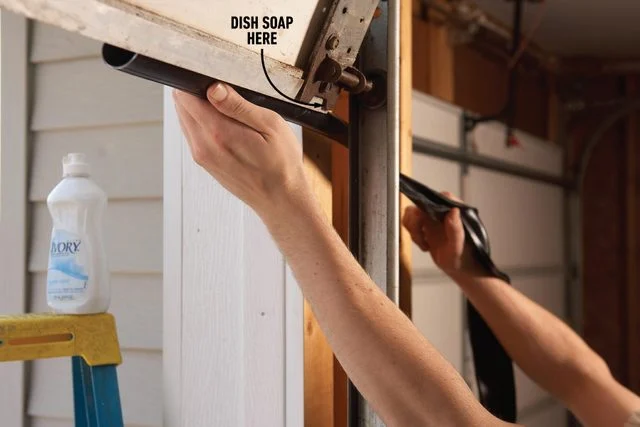Title: Sealing the Deal: Your Ultimate Guide to Garage Door Bottom Seals
June 24, 2024 | by Shunmarsh

Introduction
Ever found yourself wincing at the sight of critters sneaking under your garage door? Or maybe you’ve cursed under your breath at the puddle of water that mysteriously appears after a rainstorm. If these scenarios sound familiar, you need to know about garage door bottom seals! These unsung heroes of home maintenance keep out pests, drafts, and moisture, ensuring your garage stays clean and dry. Let’s dive into the nitty-gritty of garage door bottom seals and how they can make your life a whole lot easier.
What is a Garage Door Bottom Seal?
A garage door bottom seal is a strip of rubber, vinyl, or other durable materials attached to the bottom edge of your garage door. It creates a barrier between your garage and the outside world, blocking out unwanted elements like:
- Water
- Dirt
- Pests
- Cold air
Types of Garage Door Bottom Seals
There are several types of garage door bottom seals, each with its unique benefits. Let’s break them down:
1. T-Type Seal
The T-type seal has a T-shaped edge that fits into a single channel at the bottom of the garage door. It’s great for keeping out small pests and dirt.
2. U-Type Seal
This seal forms a U-shape when installed, providing excellent protection against water and drafts. It’s one of the most common types due to its effectiveness and ease of installation.
3. Bulb Seal
The bulb seal is round and flexible, garage door bottom seal perfect for uneven floors. It compresses when the door is closed, creating a tight seal that keeps out the elements.
4. Threshold Seal
Unlike other seals, the threshold seal is installed on the garage floor rather than the door. It works in tandem with the door seal to provide extra protection against water and debris.
Why You Need a Garage Door Bottom Seal
Now that you know what a garage door bottom seal is, let’s talk about why you should care. Here are some compelling reasons:
1. Energy Efficiency
A garage door bottom seal can help maintain a stable temperature inside your garage. During winter, it keeps the cold air out, and in summer, it prevents hot air from seeping in. This means your HVAC system doesn’t have to work as hard, saving you money on energy bills.
2. Pest Control
Bugs, rodents, and other critters love to find their way into your garage. A good seal keeps them out, protecting your belongings and reducing the risk of infestations.
3. Water Damage Prevention
Rainwater can easily seep under a poorly sealed garage door, causing damage to your floor and stored items. A bottom seal acts as a barrier, keeping your garage dry and safe.
4. Improved Comfort
Nobody likes stepping into a freezing or sweltering garage. A bottom seal helps keep your garage’s temperature more consistent, making it a more comfortable space to work or store items.
How to Choose the Right Garage Door Bottom Seal
Selecting the right seal for your garage door can feel overwhelming with all the options available. Here are some tips to help you make the best choice:
1. Measure Your Door
Before buying a seal, measure the width of your garage door. Most seals come in standard sizes, but it’s essential to get one that fits perfectly to ensure maximum effectiveness.
2. Check the Floor
Look at the condition of your garage floor. If it’s uneven, a bulb seal might be your best bet, as it can adapt to different surfaces.
3. Consider the Climate
Your local climate plays a significant role in choosing the right seal. If you live in a rainy area, opt for a seal that offers excellent water resistance. In colder regions, a seal that provides good insulation is crucial.
4. Material Matters
Seals come in various materials like rubber, vinyl, comfrt and neoprene. Rubber is durable and flexible, vinyl is cost-effective, and neoprene offers excellent weather resistance. Choose a material that suits your needs and budget.
Installing a Garage Door Bottom Seal
Installing a garage door bottom seal might seem daunting, but it’s a straightforward DIY project. Follow these steps to get the job done:
1. Gather Your Tools
You’ll need:
- A tape measure
- A screwdriver
- A utility knife
- A rubber mallet (optional)
- The new seal
2. Remove the Old Seal
Start by lifting your garage door. If there’s an old seal, remove it by unscrewing or pulling it off the door. Clean the bottom edge to ensure the new seal adheres properly.
3. Cut the New Seal
Measure the new seal against the width of your garage door and cut it to size using a utility knife.
4. Attach the New Seal
Slide the new seal into the channel at the bottom of the door. If it’s a tight fit, use a rubber mallet to tap it into place gently. Secure it with screws if necessary.
5. Test the Seal
Close the garage door and check for gaps. If the seal isn’t tight, adjust it until you achieve a snug fit.
Maintaining Your Garage Door Bottom Seal
To ensure your garage door bottom seal lasts as long as possible, regular maintenance is key. Here are some tips:
1. Regular Inspections
Check the seal every few months for signs of wear and tear. Look for cracks, holes, or areas where the seal has become loose.
2. Clean the Seal
Keep the seal clean by wiping it down with a damp cloth. Dirt and debris can cause the seal to deteriorate faster.
3. Lubricate Moving Parts
If your seal is attached to a moving part of the door, lubricate the area to prevent friction and wear.
4. Replace When Necessary
No seal lasts forever. When you notice significant damage or the seal isn’t performing well, it’s time to replace it.
Frequently Asked Questions (FAQs)
Q1: How often should I replace my garage door bottom seal?
Typically, you should replace your garage door bottom seal every 1-2 years, depending on the wear and tear and your local climate.
Q2: Can I install a garage door bottom seal myself?
Yes, installing a garage door bottom seal is a simple DIY project that most homeowners can handle with basic tools.
Q3: Do garage door bottom seals work on all types of garage doors?
Yes, there are seals available for various types of garage doors, including sectional, roll-up, and tilt-up doors. Just make sure to choose the right type and size for your door.
Q4: How do I know if my garage door bottom seal needs replacing?
If you notice drafts, water leaks, or increased pest activity in your garage, it’s a good sign that your seal needs replacing. Also, inspect the seal regularly for visible signs of damage.
Conclusion
A garage door bottom seal might not be the most glamorous part of home maintenance, but it’s essential for keeping your garage clean, dry, and pest-free. By choosing the right seal, installing it correctly, and maintaining it regularly, you can enjoy a more comfortable and efficient garage space. So, don’t wait—seal the deal today and give your garage the protection it deserves!
RELATED POSTS
View all


